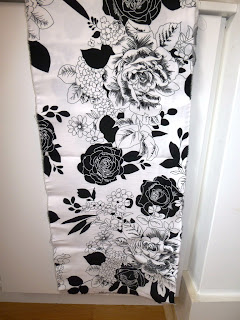I like the concept of repeating patterns building up an overall picture and impression and I enjoyed the printing exercise in the end of the assignment. When looking at some blackwork embroidery it is so rich -almost as to cover the fact that there is a repetitive pattern.
When looking a bit into Bauhaus black and white studies – I became slightly surprised as I had believed that the Bauhaus movement was quite a strict “functional” and to some extent minimalistic movement. There were several pictures being quite rich and with my absolute minimalistic experience of art, I got impressions from both Chagall, Matisse and Miro when looking at a few. On the other hand – studies of buildings and architectural motifs were more strict. To remind me – the “Bauhausers” were contemporary with the artists I mentioned above.
Looking into the ethnic patterns, African and Uzbekistan, it is an interesting thought that I believe that all cultures have used the technique to repeat patterns – carpets – kelims and virtually all oriental carpets and textiles; kurbitz (Scandinavia), well I guess I could get on.
The factor of rhythm I have never really thought about or noticed (or rather been made to notice). However, I do guess that little wall cabinets with finds from the beach or from nature that you would find in most homes – not the least homes with children, are a parallel to the example of Damien Hirst in the course sheet.
Task 1: Patterns on paper and fabrics
I have collected – bought a few pieces of materials displaying a variety of black and white pattern, and I will make o few comments for each of them. However, I will not cut out a piece of them – as if I do, I will not be able to make o scarf from the pieces, which I will actually be able to do from four of them!
a) Rich pattern, black on white polyester
This fabric is a bit “crepy”, by means of minute pleats in the structure. It is see
through, chiffon like.
It is not very beautiful, but it is built up from a large number of patterns, lines and marks. The dominating feature is a flower which is in turn built up from several mall patterns included in the petal leaves. This flower is repeated – and is repeated in inverse colours as well. There is one further large structure, also a flower with a further large number of small lines and marks filling its different structures. This flower structure is repeated, but every second repetition is broken by the insertion of flower pattern number one.
Spaces between these flower structures, in four different varieties, are filled with a smallish pattern, sometimes in two directions. In addition, one discovers there are a variety of independent patterns of leaves and flowers, filled with an independent pattern of lines. Not until one really analyses the number of “bodies” and pattern components, one realizes how many they are. I believe there are about ten principal components – in addition to about as many principal basic patterns of lines and marks.
b) Black and white cotton with large pattern components
This fabric is a cotton satin, very white and very obvious and large pattern groups. There are some very black components and hence a rather “unruly” impression.
There seem to be some five main black flower components, and about five different white flower heads. There are a large number of different leaves, black and white with different marks on them. In addition there is a large variety of smaller flower bunches and “grapes”, but also individual and independent smaller flowers.
c) Cream silk (or poly) with one principal repeated black pattern
This fabric includes one principal component, but it is itself built up from several individual pattern components, arranged in a group to form the structure. There are about ten different smaller marks, lines and figures used to build the pattern structure. I feel the fabric has quite a rhythm and a softness due to the slightly “subdued” background in combination with the “brush stroke” character of each individual mark.
d)Black viscose crèpe with circle white print
d)
This is an amusing pattern, as I have tried to find the structure, or individual component repetitive structures used to build it up, but I have not quite managed. Of course the obvious – different size and form of the circles – but otherwise difficult to see. One can identify a few bigger clusters, kind of flowerlike, but as soon as one tries to find more, the eye or brain gets confused. Also diagonal strings of intertwined circles – yes – as straight lines of them – yes but still the repetitions are difficult to find.
a) Simple small patterns repeated in several larger geometrical clusters
The last fabric, a light fluid cloth of crepe character is patterned by two simple rectangular types of small patterns, varied by colour inversion and combined by scraps of lines, and one type of circles and wavy lines, also varied by inversion. In addition there is a zig-zag pattern, also inversed. These patterns have been gathered in rhomboid areas and a fairly rich pattern has been built by simple patterns and marks.










No comments:
Post a Comment